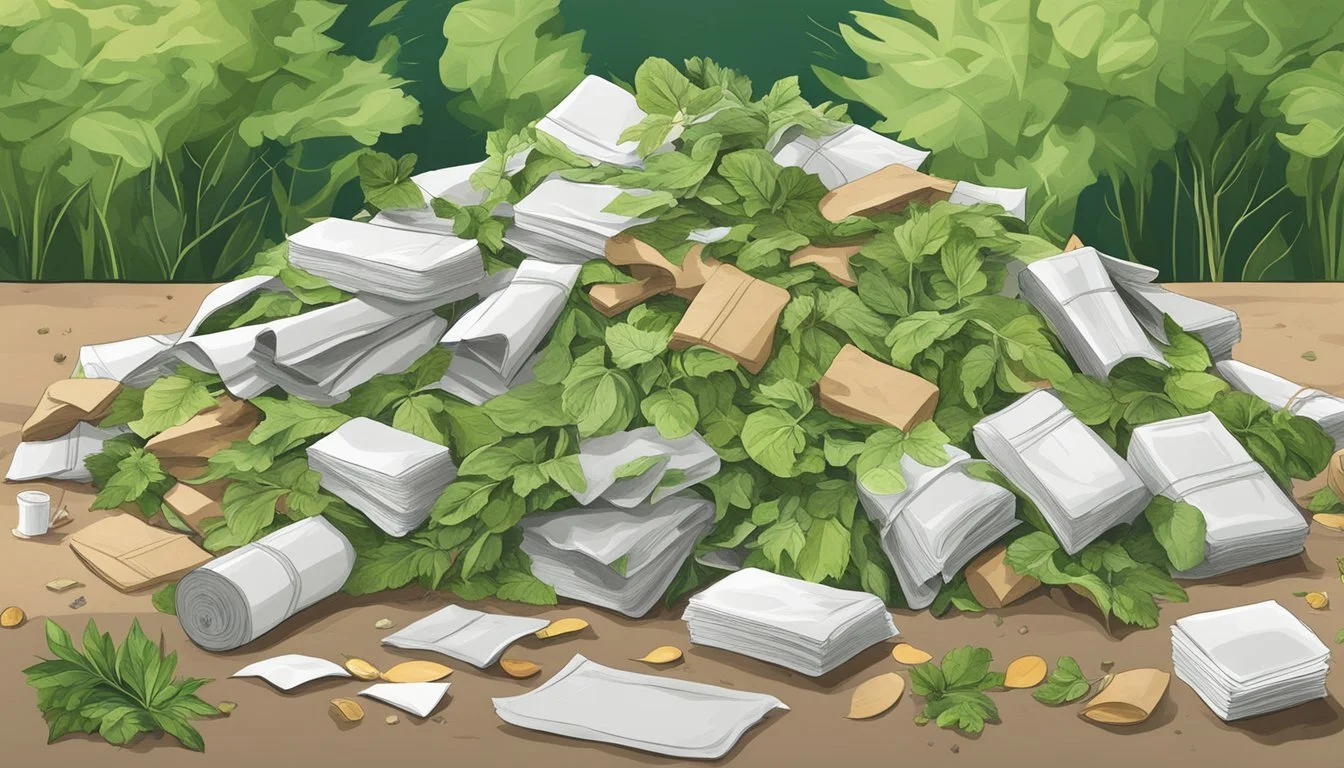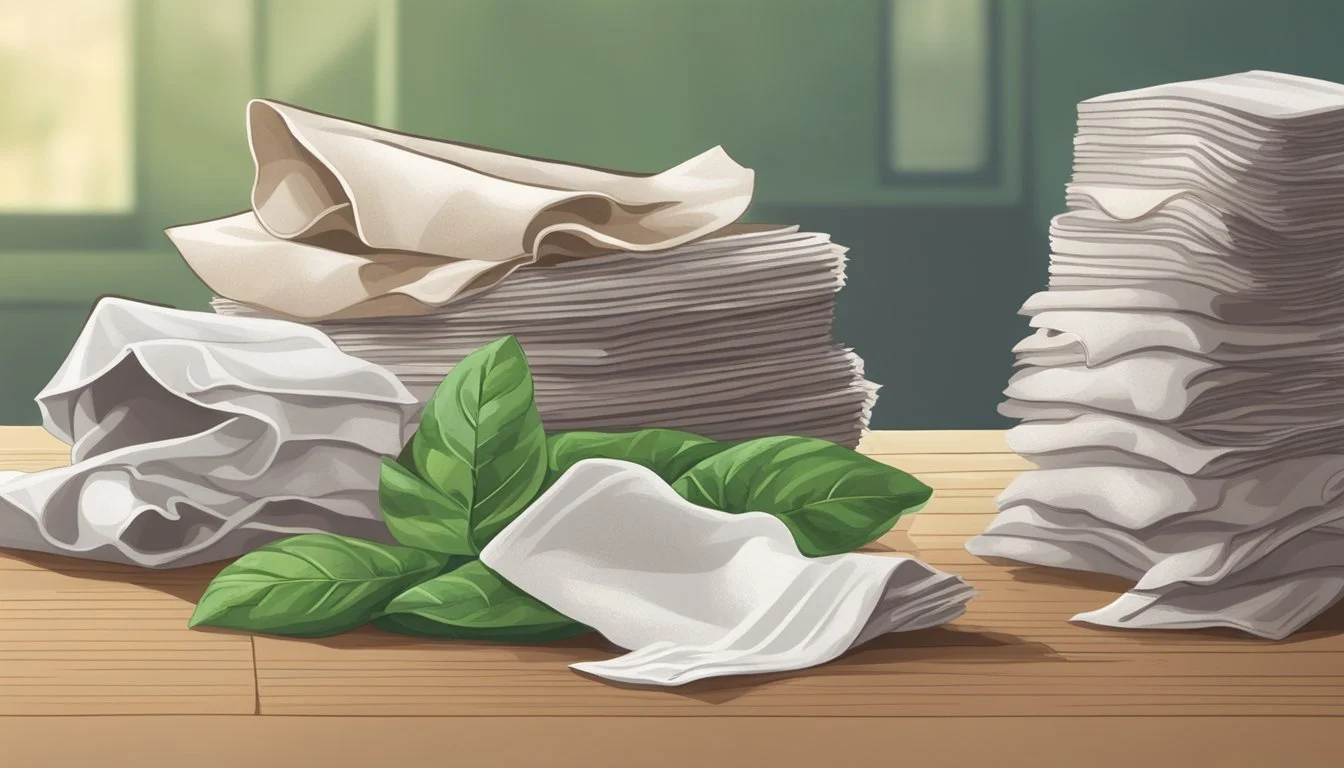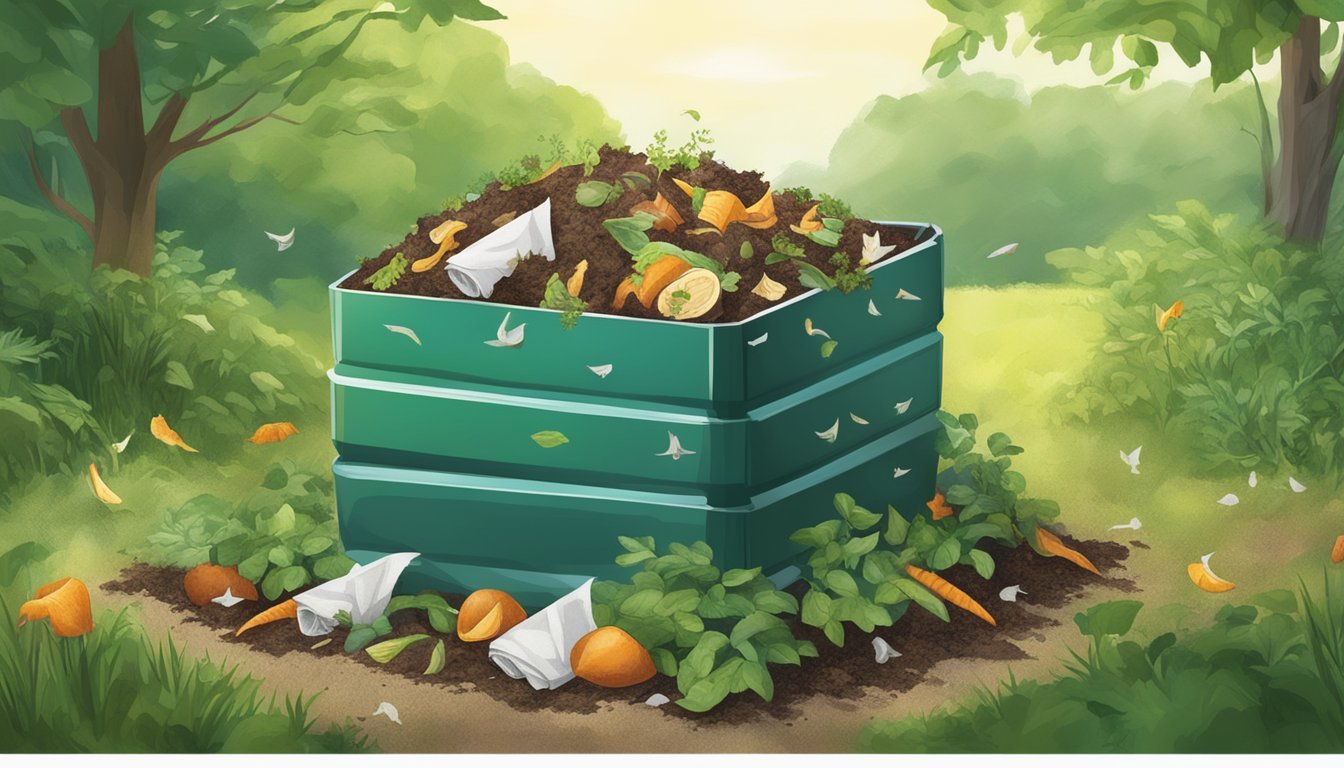Can You Compost Napkins?
Unveiling the Truth About Paper Waste Recycling
Composting has become a popular eco-friendly practice that contributes towards reducing waste and enriching soil health. Within this realm of waste management, the compostability of various products is often a subject of inquiry, including everyday items like paper napkins. As it turns out, paper napkins can be a suitable addition to compost piles under the right conditions.
When considering napkins for composting, it's important to evaluate their condition. Clean or unused napkins are certainly compostable – they break down over time and add to the carbon-rich 'brown' layer that is essential for a balanced compost mix. However, napkins soiled with organic material such as food scraps are also compostable, with the caveat that those tainted with oils or chemicals should be excluded to avoid contaminating the compost.
Composting napkins can be an effective way to reduce landfill waste and can help create a nutrient-rich amendment for gardens. The incorporation of napkins into compost is generally straightforward, but attention must be paid to the overall balance of compost ingredients, ensuring that there is a proper mix of 'green' and 'brown' materials to optimize the decomposition process.
Understanding Compostability
Composting converts organic matter into nutrient-rich soil through biodegradation. Understanding its principles ensures effective and eco-friendly composting practices.
Defining Composting and Compostability
Composting is the process by which organic matter is transformed into compost through microbial activity. Compostability refers to the ability of materials to break down in a compost system, becoming part of usable compost. Items considered compostable should decompose into non-toxic, nutrient-rich organic matter that can benefit soil health.
The Science of Decomposition
Decomposition is the biological breakdown of organic materials by microorganisms. This natural process requires four main elements: organic matter, microorganisms, oxygen for aeration, and moisture. The end product is humus-like material, which enriches soil and provides nutrients for plant growth.
Biodegradation versus Composting
Biodegradation is the process wherein any biodegradable material is naturally broken down by biological agents. Composting is a more controlled form of biodegradation where organic waste is broken down in a compost pile or bin under conditions that promote the activity of decomposers.
Benefits of Composting
Composting has multiple environmental benefits. It reduces the need for chemical fertilizers, cuts down on methane emissions from landfills, and contributes to soil health by replenishing vital nutrients. Overall, it is an environmentally sound waste management and soil amendment practice.
Composting Systems
Several types of composting systems exist, including home composting bins, bokashi composting, and large-scale industrial operations. Each system uses particular methods to achieve aeration and control moisture, carbon, and nitrogen ratios to facilitate decomposition and produce quality compost for various uses.
Compostable Materials Overview
This section focuses on understanding the range of compostable items and the balance necessary for a successful composting process, highlighting the importance of differentiating between biodegradable and non-compostable items.
Identifying Compostable Materials
Materials that can be composted are typically organic and biodegradable. Compostable items are usually categorized as either green materials, which are nitrogen-rich, or brown materials, which are carbon-rich. While green materials include fruit and vegetable scraps and grass clippings, brown materials encompass items like leaves and cardboard.
Composting Food Scraps
Food scraps, particularly from fruits and vegetables, are excellent for composting. They break down quickly and add essential nutrients to the compost pile. However, it's crucial to avoid composting meat and dairy, as these can attract pests and create odor problems. Eggshells and coffee grounds can be added as they are rich in beneficial elements.
Paper Products in Composting
Not all paper products are equal when it comes to composting. Paper napkins, paper towels, and unbleached paper can be composted, whereas coated, printed, or brightly colored paper may contain chemicals and inks that are not suitable. Recycled and unbleached paper products are more sustainable and safe for composting.
Distinguishing Brown and Green Composting Materials
Maintaining a proper balance between green and brown materials is integral to the composting process. Green materials supply nitrogen, while brown materials provide carbon, which is necessary for the microbes in the compost to thrive. For a good balance, aim for a ratio of about 1 part green to 3 parts brown material.
Green Material:
Grass clippings
Fruit and vegetable scraps
Coffee grounds
Brown Material:
Dry leaves
Twigs
Cardboard
Composting is a sustainable method to recycle organic matter, turning what would be waste into valuable resources for the garden or farm.
Napkins and Composting
Composting napkins can play a significant role in waste reduction efforts, contributing to a sustainable environment.
Paper Napkin Composition
Paper napkins are typically made from either virgin or recycled paper pulp, which is naturally biodegradable. Virgin paper napkins are often softer and more absorbent, while recycled napkins contribute to reducing waste. The biodegradability can be compromised when napkins are bleached or contain synthetic dyes.
The Compostability of Napkins
Most paper napkins are compostable because they decompose into organic matter. However, their compostability is impacted by what they have been used to clean up. Napkins soiled with compostable food waste can be added to a compost pile, but those used with non-compostable substances like oils and chemicals should be avoided.
Handling Non-Compostable Napkins
Napkins saturated with plastic, synthetic materials, or heavy chemicals do not belong in the compost. Disposal should be handled with care to minimize environmental impact, preferably by recycling if possible.
Cloth Napkins Versus Paper Napkins
Cloth napkins are a sustainable alternative to paper napkins, being reusable and reducing single-use waste. When they reach the end of their lifecycle, napkins made from natural fibers can be composted, as long as they are free of synthetic fibers and non-biodegradable treatments.
Pre-Treatment for Composting Napkins
Before composting, paper napkins should be shredded to accelerate their decomposition. They should be mixed properly to maintain moisture and airflow in the compost pile, facilitating the breakdown into soil-enriching material.
Composting Guidelines and Best Practices
Incorporating napkins into compost requires adherence to best practices to ensure that the composting process is both efficient and environmentally responsible. This section outlines critical strategies for building and managing a compost pile, avoiding common pitfalls, and understanding the decomposition process to comply with composting standards, all of which contribute to a positive environmental impact.
Building and Managing a Compost Pile
A compost pile requires a balanced mix of brown materials (such as dry leaves and paper products like napkins) and green materials (like food scraps), which provide carbon and nitrogen, respectively. Ideal compost piles maintain a ratio of roughly 30:1, carbon to nitrogen. Consistent moisture and aeration are crucial, with the pile's temperature needing to remain between 140°F and 160°F to support microbial activity that decomposes the organic matter effectively.
Avoiding Composting Pitfalls
To avoid attracting pests or creating contaminants, it's essential not to compost napkins used to clean up chemical spills, non-organic materials, or synthetic fibers. Also, be cautious of materials that do not break down easily, such as coated, printed, or bleached paper products, as these can introduce unwanted chemicals into the compost.
Ensuring Proper Decomposition
Efficient decomposition requires an environment where microorganisms can thrive. An adequate balance of airflow, carbon, nitrogen, and water is essential. Regular turning of the compost pile increases oxygen flow, which alongside proper hydration accelerates the decomposition of organic matter, including biodegradable napkins.
Complying with Composting Standards
Not all napkins are equal in compostability. For a napkin to be composted, it should ideally be made from biodegradable materials such as unbleached paper or plant-based products. Certified compostable products are typically labeled and meet specific standards that guarantee their ability to break down in compost systems without leaving harmful residues.
Environmental Impact of Composting
Composting, including the addition of biodegradable napkins, supports sustainability by converting organic waste into nutrient-rich soil amendments. This practice not only minimizes landfill usage but also helps to reduce greenhouse gas emissions, cutting down the overall carbon footprint and promoting an eco-friendly approach to waste.
Lifecycle Implications and Sustainability
Implementing compostable napkins into waste management strategies has considerable effects on sustainability and the environment. From the point of disposal to their ultimate transformation into soil enrichments, each stage carries implications for ecological balance and resource efficiency.
From Composting to Soil Amendment
Soiled paper napkins, when composted, decompose into organic matter that enriches soil with nutrients. This transformation from waste to a resourceful soil amendment highlights the beneficial cycle of returning organic materials to the earth, supporting plant growth and enhancing soil health without the need for chemical fertilizers.
Comparing Composting to Recycling
Compared to recycling, where fibers from napkins may be too thin to repurpose, composting offers a more viable solution. Recycling demands significant energy and often faces contamination challenges, whereas composting aligns closely with the principles of sustainability by reducing resource use and energy expenditure.
Reducing Landfill Waste
Composting napkins reduces the volume of waste destined for landfills. Each napkin diverted from landfill is a step towards lessening methane emissions, a potent greenhouse gas, and reducing the environmental footprint associated with storing single-use items long-term.
Economic and Resource Efficiency
Composting can prove to be more economically feasible than other waste management practices. It minimizes the need to invest in landfill space and the associated costs of transport and maintenance, thereby conserving valuable resources and money.
Sustainable Living and Waste Reduction
Encouraging the composting of napkins promotes sustainable living practices. It plays a part in waste reduction efforts by offering an alternative to throwing away single-use items, aiding communities in embracing eco-friendly habits.
Choosing Eco-Friendly Products
Opting for napkins labeled as "certified compostable" ensures they are free from plastics like polyester and designed for effective degradation in a compost environment. This conscious product selection reflects a commitment to sustainability and resource conservation.
The Role of Composting in Agriculture
In an agricultural context, composting contributes to long-term soil health. The addition of composted napkins introduces vital organic matter that improves soil structure, water retention, and drainage, and encourages the activity of beneficial microorganisms, culminating in healthier crops and reduced dependency on chemical fertilizers.
Frequently Asked Questions
Composting napkins is an effective way to reduce waste, provided they meet certain criteria for compostability. This section answers common questions pertaining to the composting of napkins.
What Types of Napkins Are Compostable?
Unbleached napkins made of recycled paper are typically compostable. Compostable napkins should ideally be marked as certified biodegradable materials. If the napkin is plain, uncolored, and not heavily soiled, it can be added to the compost pile.
How to Determine Napkin Compostability?
The compostability of a napkin can often be determined by the certifications on the packaging. For napkins without clear labels, consider if they are uncolored or made of recycled paper. Heavily soiled napkins, especially with grease or chemicals, should not be composted.
Can Dyed or Printed Napkins Be Composted?
Care should be taken with colored or printed napkins as they may contain dyes that are not suitable for composting. Composting is best for napkins dyed with biodegradable dyes. When in doubt, opt for undyed, unprinted napkins for composting to prevent contamination.
How Long Do Napkins Take to Decompose?
The decomposition rate for napkins in a compost pile can vary. It depends on factors like moisture, temperature, and overall composting conditions. Generally, a napkin may take a few weeks to several months to decompose, contributing to the compost's brown materials, which provide carbon.
Conclusion
Composting napkins is a feasible and eco-friendly method of waste management, contributing to sustainability efforts. When adding napkins to a compost bin, individuals adhere to the principle of reducing landfill usage and supporting a greener environment. The material of most paper napkins is biodegradable and can adequately break down within a composting system, transforming into useful organic matter for soil enrichment.
However, not all napkins are suitable for composting. Napkins soiled with organic matter such as food residues or plant-based liquids can indeed be composted. In contrast, napkins contaminated with grease, oil, or chemicals should not be composted as they can disrupt the balance of the compost and potentially introduce harmful elements into the system.
For those seeking an alternative to paper napkins, cloth napkins provide a reusable and washable option. While composability is straightforward for paper, cloth napkins should not be disposed of in a compost bin but rather can serve multiple uses before being considered waste.
In practice, effective composting of napkins requires:
Separation of heavily soiled or non-compostable napkins.
Ensuring a balanced compost pile with a mix of greens (nitrogen-rich materials) and browns (carbon-rich materials).
By adhering to these practices, consumers contribute to an effective composting process, fostering a more sustainable approach to everyday waste.






